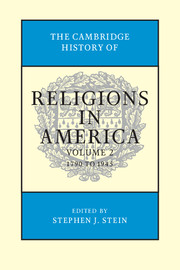Book contents
- Frontmatter
- Contents
- Contributors
- Editor's Introduction
- SECTION I RELIGION IN NORTH AMERICA
- SECTION II RELIGIONS IN THE NEW NATION, 1790–1865
- SECTION III CHANGING RELIGIOUS REALITIES
- SECTION IV RELIGIOUS RESPONSES TO MODERN LIFE AND THOUGHT
- SECTION V COMPARATIVE ESSAYS
- SECTION VI RELIGION AND DIVERSE AREAS
- 34 Religion and Literature, 1790–1945
- 35 Religious Music: A Mirror and Shaper of American Christianity
- 36 Religion and the News
- 37 Religion and the Media, 1790–1945
- 38 Religion and the Courts, 1790–1947
- 39 Religion and Patriotism in America, 1790–Present
- Index
- References
38 - Religion and the Courts, 1790–1947
from SECTION VI - RELIGION AND DIVERSE AREAS
Published online by Cambridge University Press: 28 July 2012
- Frontmatter
- Contents
- Contributors
- Editor's Introduction
- SECTION I RELIGION IN NORTH AMERICA
- SECTION II RELIGIONS IN THE NEW NATION, 1790–1865
- SECTION III CHANGING RELIGIOUS REALITIES
- SECTION IV RELIGIOUS RESPONSES TO MODERN LIFE AND THOUGHT
- SECTION V COMPARATIVE ESSAYS
- SECTION VI RELIGION AND DIVERSE AREAS
- 34 Religion and Literature, 1790–1945
- 35 Religious Music: A Mirror and Shaper of American Christianity
- 36 Religion and the News
- 37 Religion and the Media, 1790–1945
- 38 Religion and the Courts, 1790–1947
- 39 Religion and Patriotism in America, 1790–Present
- Index
- References
Summary
When the Framers drafted the U.S. Constitution in 1787, the only mention of religion was the remarkable text of Article VI, which states, “[N]o Religious Test shall ever be required as a Qualification to any Office or public Trust under the United States.” That ground-breaking language marked a shift from prior practice in Europe and the states. At the time of the Constitution's drafting, most states had religious qualifications for government officials, following the pattern in Britain, where the monarch was required to be a member of the Church of England. In Europe the guiding principle was cuius regio, eius religio: the religion of the people is determined by the religion of the ruler.
Many of the Framers, especially James Madison, believed that the new Constitution protected liberty of conscience by creating a government of enumerated and separate powers that gave Congress no authority over religion. During the ratification process, however, constitutional critics demanded greater protection of individuals from the power of the government. In order to secure the Constitution's ratification, the new Congress drafted a Bill of Rights that protected religious freedom in the following language: “Congress shall make no law respecting an establishment of religion, or prohibiting the free exercise thereof.” Upon ratification by the states in 1791, the language about religion became the First Amendment to the U.S. Constitution. The two Religion Clauses of the First Amendment are known as the Establishment Clause and the Free Exercise Clause.
- Type
- Chapter
- Information
- The Cambridge History of Religions in America , pp. 832 - 852Publisher: Cambridge University PressPrint publication year: 2000



